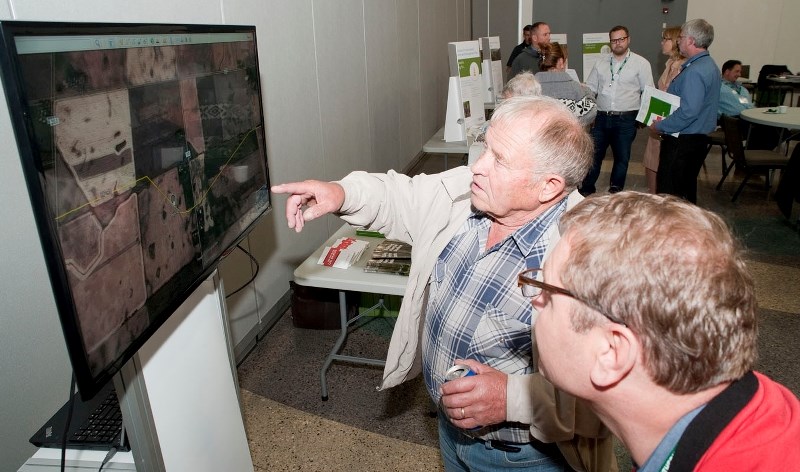A major oil company wants county residents to tell them about their concerns about the Northern Gateway pipeline.
About 50 people came to the Morinville Community Cultural Centre last week for an open house on the proposed Northern Gateway pipeline – the first of three planned for Alberta.
The $6.5 billion project, once built, will carry up to 525,000 barrels of oil a day from Bruderheim, about 40 km northeast of St. Albert, to Kitimat, B.C., and pass through Sturgeon County.
Many aboriginal and environmental groups, especially in B.C., opposed the project due to its potential to harm wildlife off the B.C. coast.
The federal government approved the project earlier this year subject to 209 conditions, including a requirement to survey and monitor its effects on wildlife, wetlands, air and soil.
About 113 of those conditions must be met before construction can begin, said Michele Perret, director of community engagement with Enbridge. Most of those involve talks with local residents.
"What we're really looking to get is feedback from the community," said Brian Lynch, a consultant on the project with Stantec. Enbridge needs to know about streams, wetlands, forests, bear dens and other environmental features important to residents so it can incorporate them into its wetland, marine, fish, caribou, traditional land use and rare plant monitoring and protection plans.
The route
The 1,177-km project involves two pipelines, both of which start northeast of the Shell Scotford site near Fort Saskatchewan.
The bigger, 36-inch pipe will carry oil diluted with condensate from Alberta to B.C., Perret said. The smaller, 20-inch one will return the condensate to Alberta.
The project was designed in order to minimize land disturbance, said Raymond Doering, project services director with Enbridge.
"In Alberta, almost 100 per cent of the route is following existing linear features," he noted, such as the Alliance pipeline (which the Northern Gateway will parallel for about 300 kilometres).
The project heads across the North Saskatchewan River west through Sturgeon County past the Agrium fertilizer plant and north of Gibbons, Bon Accord and the Sturgeon River, Doering said. The pipelines will not cross the Sturgeon, he added.
The pipelines will pass about five km north of Morinville and stay at least 100 metres from any homes. The lines run through the north edge of Alexander First Nation at the local council's request, Doering said (the pipeline would create tax revenue).
The lines do pass 20 km north of Lac Ste. Anne, Doering said. Due to the slope of the land, any spilt oil from a break would flow north away from the lake.
"We'll have lots of isolation valves along the pipeline," Doering said – about 132 per pipe – designed to isolate any breaks and minimize spills.
Enbridge plans to build the line in about 20 segments of 100 km, Doering said. Crews will work from one end of a segment to the other in waves, digging, laying, testing and reburying pipe as they go, so that no more than 10 km of trench is open at any one time. They also plan to dig under roads so they won't have to close them during construction.
The line will cut through about 500 wetlands, said Wayne Bessie, a consultant working on the project's wetland assessment plan. While some of those wetlands can be restored simply by replacing the soil, others, such as fens or forests, may be permanently transformed or removed. Enbridge will have to inventory all wetlands along the line's route before it starts construction, as this will determine the amount of compensatory wetland it has to build to cover what is lost.
Local concerns
Farmer John Hesse said that the pipeline would go through about 1.6 km of his land northwest of Morinville. He is negotiating a compensation deal with Enbridge as a result.
Hesse said he had no particular concerns about the line and had never had any issues with a similar pipeline just south of his land.
"They're probably safer than what we have with the railroads," he added, referring to oil transport by rail.
Enbridge should minimize the negative impacts of this project if it walks the talk when it comes to its environmental measures, said farmer Bill Bocock. Still, he remains concerned that the project meant more investment in the Alberta oilsands.
"We're trying to cut down on pollution and greenhouse gases and global warming, and the tar sands are contrary to that."
Consultations are set to wrap up in early 2016, Perret said.
Comments and questions should go to gatewayfacts.ca or [email protected].




